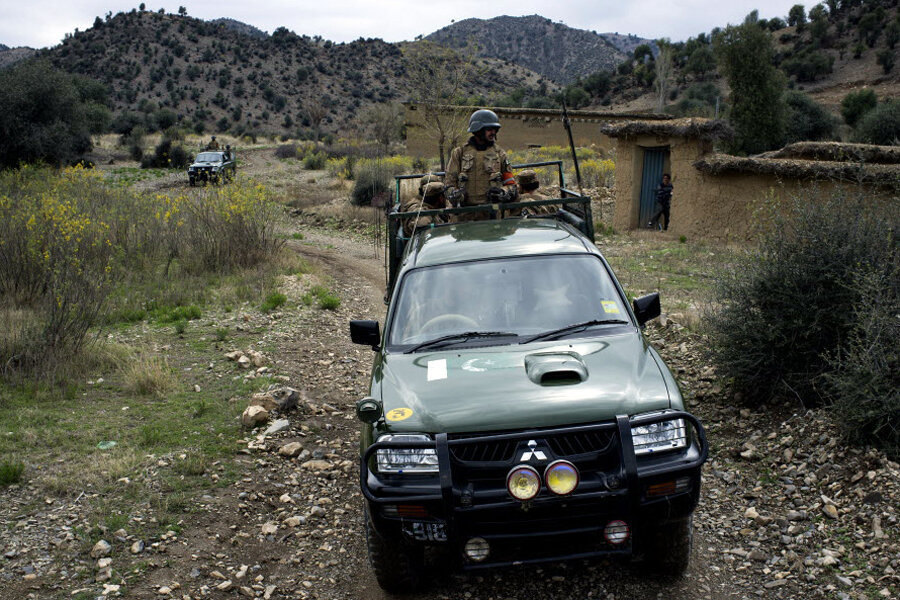Can Pakistan drive the Taliban out of its tribal belt?
Loading...
| South Waziristan, Pakistan
Impoverished and perpetually neglected by the country’s central government, the semi-autonomous tribal regions of northwest Pakistan have long been a simmering source of both national and regional tension.
For years, the country’s central government has tacitly allowed extremist groups like Al Qaeda and the Taliban to use the region as a kind of haven for militants waging conflicts just across the border in neighboring Afghanistan. Meanwhile, the aftershocks of that conflict have spilled over into the tribal areas’ civilian population, disrupting education and economic activity.
Now, with the 2014 withdrawal of NATO troops in Afghanistan looming, the Pakistani government is reexamining its role in the long-neglected region and renewing its counterinsurgency efforts against militants. But many analysts, local leaders, and residents question whether the country has either the will or the resources to truly reform its tribal belt.
"The tribal areas have been knowingly neglected socially and constitutionally by successive regimes since independence," says Rahimullah Yousafzai, an expert on the Federally Administered Tribal Areas (FATA), as the regions are collectively known.
Indeed, the Pakistani military claims it has now secured control in many areas of FATA – the most recent win in South Waziristan, where a military operation was launched in 2009. But even those areas have yet to be transferred to the hands of the civilian administration, and many others are not under the government's control at all.
A history of division
Since British colonization, the region’s seven geographically divided “agencies” have not been an official part of Pakistan. In 1901, to appease tribal leadership wary of a centralized government, the British introduced a separate governing system in FATA, known as the Frontier’s Crimes Regulations (FCR), which continued after Pakistan's independence in 1947.
Under the FCR, the tribal areas are governed by federally appointed political administrators who have absolute executive, legislative, and judicial power in each agency. Constitutional civil rights afforded to the rest of Pakistan do not exist.
“The government also gives many privileges to the tribal leadership like money, land, etc.," says Safdar Hayat, former president of the Tribal Union of Journalists, who hails from North Waziristan, where the Taliban are headquartered. "These privileges are not allocated as rights of civilians but only for those heads of tribes who do not question the FCR.”
Added to that is instability in neighboring Afghanistan, which has bled over into the region and contributed to a low educational attainments and high poverty. Along with rigid cultural traditions, these factors have held the tribal areas back in terms of socio-economic development compared with the rest of Pakistan. They have also fueled concern about the insecurity and militancy spreading beyond the region.
But bringing the region under the control of the Pakistani government isn’t an easy task, officials argue.
A 'warrior-like' people
Ethnic groups in Pakistan’s tribal belt have fought against foreign aggression for centuries. The British, Americans, and then Pakistanis all took advantage of their outside reputation as a warrior-like people, setting up the current dynamic.
“Pre-independence, the British exploited the folklore of Pashtun bravery to keep the Afghans from entering their colonial-ruled regions of the subcontinent,” says Nizam Dawar, who is a development specialist based in the tribal region. “Post-independence we allied with the Americans, and used the same Pashtun tribes to ward off communism from [the Soviet Union],” says Mr. Dawar.
When the US invaded Afghanistan in 2001, however, those same American-trained militants began clashing with NATO forces and then retreating to Pakistan for sanctuary.
Also complicating matters, the Pakistani military under Gen. Pervez Musharraf made peace pacts with the militants based in FATA during the NATO-led Afghan war, tacitly allowing them haven, while also continuing to ally itself with the United States against its “war on terror.”
Twelve years later, many security experts say the military still does not want to burn bridges with Afghan militants in FATA, which it sees as a potential way to influence what happens to Afghanistan after NATO pulls out in 2014.
What next?
Analysts, local leaders, and even some in the military emphasize that the legal framework in FATA needs to be repealed and constitutional rights granted to its citizens to ensure social and infrastructural development.
“Where is the civilian leadership? Even now, the military is chipping in more than anyone else. We should pull our act together, since we have been neglecting this region for over 65 years,” says Brigadier Hassan Hayat, an operational commander, who has been posted in South Waziristan for the past two years rehabilitating refugees and maintaining law and order.
More than $150 million has been pledged by countries like the US, Britain, and Germany in a bid to revive the livelihood of people beset by terrorism and natural disasters in Pakistan, according to statistics by provided by the Multi-Donor Trust Fund. Many of their projects focus on FATA.
But despite so much inflow, development workers say the outlook remains grim as aid is channeled through the military – instead of civilian authorities.
“The tribal belt has now become a hotbed for war economy. With some much money pouring in from all over the world for development, the main stakeholders – especially the military – are now also financially benefiting from keeping the conflict alive,” Mr. Dawar, the development worker, says.
“FATA continues to stay out of constitutional ambit because the military wants absolute control over the strategic belt,” echoing history, he says. “The civilian leadership remains sidelined.”








